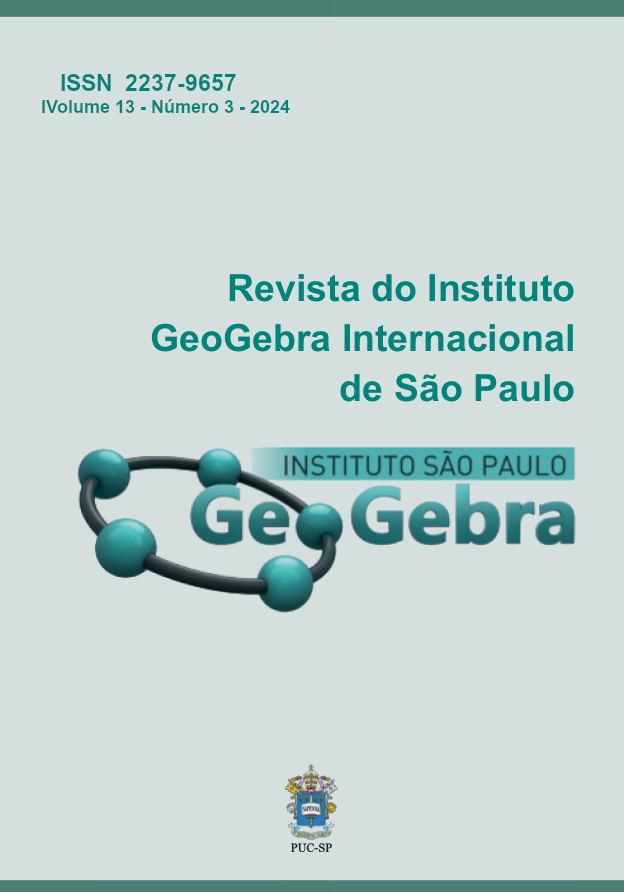Geometric visualization in trash bins
DOI:
https://doi.org/10.23925/2237-9657.2024.v13i3p065-084Keywords:
geometry, visualization, creativity, GeoGebraAbstract
The abstract In this paper work we are bringing a qualitative and theoretical research that aimed to analyze photographed images seen of trash bins viewed in an environment in a city in the state of Rio Grande do Sul. In such concrete objects from the real world, the researcher found representative forms of geometric entities involving shapes and that can be explored for teaching and learning of Geometry. The analysis of these objects was connected to the objects contained in the literature and which are part of course curricular. Methodologically, this is a theoretical investigation in which the Geogebra software was used to enable the aspects visualized intuitively by the observer-researcher to be confirmed and, thus, enabling records that would facilitate the process of understanding and formalizing certain concepts involved. We conclude that visual skills can provide the development of geometric thinking.
References
BAUER, M.W; AARTS, Bas. A construção do corpus: um princípio para coleta de dados qualitativos. In: (Bauer, M.W; Gaskel, G, (org.) Pesquisa qualitativa com texto, imagem e som: um manual prático. Petrópolis, RJ: Vozes. 2015. pp. 39-63.
BRASIL. Ministério da Educação. Base Nacional Comum Curricular. CNE, Brasília: 2018. Disponível em: http://portal.mec.gov.br/cne/arquivos/pdf/rcp01_02.pdf . Acesso em: 20 mar. 2024.
FISCHBEIN, Efraim. Intuition in science and mathematics: an educational approach. Dordrecht: Reidel, 1987.
LEIVAS, J.C.P. Imaginação, Intuição e Visualização: a riqueza de possibilidades da abordagem geométrica no currículo de cursos de licenciatura de matemática. Tese (Doutorado em Educação). Universidade Federal do Paraná. Curitiba. 2009.
LEIVAS, J.C.P. PITÁGORAS E VAN HIELE: UMA POSSIBILIDADE DE CONEXÃO. Ciência & Educação, v. 18, n. 3, p. 643-655, 2012.
LOIZOS, P. Video, filme e fotografia como documentos de pesquisa. In: (Bauer, M.W; Gaskel, G, (org.) Pesquisa qualitativa com texto, imagem e som: um manual prático. Petrópolis, RJ; EditoraVozes. 2015, pp. 137-186.
OSTROWER, Fayga. Criatividade e Processos de Criação. Editora Vozes. RJ. 187p. 1977.
PIAGET, Jean; INHELDER, Bärbel. A representação do espaço na criança. Porto Alegre: Artes Médicas, 1993.
PONTE, J.P. da, MATA-PEREIRA, J.; Henriques. O raciocínio matemático nos alunos do ensino básico e do ensino superior. Praxis Educativa, Ponta Grossa, v. 7, n. 2, p. 355-377, jul./dez. 2012.
Princípios e Normas para a Matemática Escolar. Lisboa: APM, 2008. Tradução dos Principles and Standards for School Mathematics, NCTM.
SEVERINO, A.J. Metodologia do trabalho científico. Cortez Editora, SP, 2016.
SILVA, Josafá L. da; PAIVA, Jussara P. A. A. Visualização geométrica: uma habilidade para ser valorizada no ensino fundamental, 2012. Disponível em https://repositorio.ufpb.br/jspui/handle/12. Acesso em 29 abr.2024.
WAHAB, Rohani Abd; ABU, Mohd Salleh Bin; ABDULLAH, Abdul Halim Bin; MokhtarMahani Bt, ATAN, Noor Azean Br. A case study on visual spatial skills and level of geometric thinking in learning 3D geometry among high achievers. 2016. Disponível em https://www.researchgate.net/publication/298640083. Acesso em 04 mai. 2024.
Downloads
Published
How to Cite
Issue
Section
License
Copyright (c) 2024 Journal of the GeoGebra International Institute of São Paulo

This work is licensed under a Creative Commons Attribution 4.0 International License.
Submission, processing, and publication of articles sent to the journal and registration of the DOI at Crossref is free of charge.
Authors retain their copyright and grant the journal the right of first publication of their article, which is simultaneously licensed under a Creative Commons - Attribution 4.0 International license CC BY that allows others to share the article by acknowledging its authorship and initial publication by the journal.
The GeoGebra journal encourages its authors to register their work with information and communication management systems aimed at researchers, such as Academia.edu, Mendeley, ResearchGate, etc.


 10.23925
10.23925
